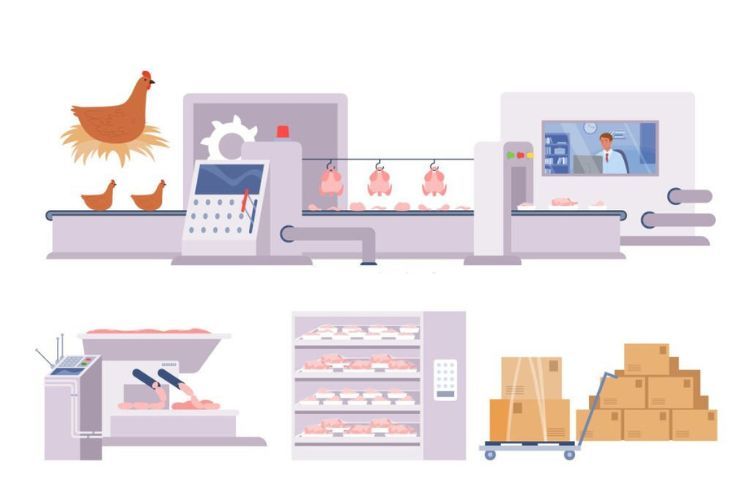
How Poultry are slaughtered and Processed for Meat?

How Poultry are slaughtered and Processed for Meat?
Broiler birds (meat chickens) might take up to seven weeks to reach market weight. Workers trained in humane care arrive at the farm to collect each chicken by hand once they've attained the appropriate size and weight. During this operation, chickens are put into holding cages or modular bins created for transit to the processing facility to ensure that birds do not injure themselves or other birds and that air may circulate.
We've broken down the remaining phases of how chickens are slaughtered and processed for meat to explain them in greater depth.
Step 1: Arrival at the Processing Plant
The well-being of chickens is carefully monitored while they are reared on the farm, and the same is true during their brief journey to the processing factory. The birds don't go large distances because this excursion is usually less than 60 miles distant.
Step 2: Stunning
Workers trained in humane handling delicately hold the birds by their feet on a moving line after they arrive at the processing factory. The hens get quiet in a couple of seconds thanks to "rub bars," which create a pleasant touch on the chicken's breast. This, in conjunction with dim illumination, is used to soothe birds.
Every effort is made in modern poultry processing factories to process hens fast and painlessly. Before the killing, they are made unconscious and painless. The predominant method of stunning broilers before slaughter in the United States s "electrical stunning." It is the most often used way of putting birds asleep. A few establishments in the United States use controlled atmosphere stunning (CAS) devices for broilers. Carbon dioxide is used in these systems to render birds insensible. Another CAS system stuns birds by lowering the air pressure.
Step 3: Slaughter
To avoid the agony, technology has made slaughter incredibly rapid. While a single slash to the throat of an unconscious bird is often successful, if the blade happens to miss for whatever reason, skilled professionals are on hand to immediately euthanize any surviving birds. Proper equipment maintenance and this backup “human” mechanism are critical to a quick and humane killing procedure.
Step 4: “Evisceration”
Following the killing, the feathers of the birds are removed. This is required to prepare the bird for processing. This is done by immersing the chicken in hot water for a few minutes to loosen the feathers. A "picker" machine with hundreds of tiny rubber "fingers" that involve extracting the feathers is used to remove them. After the feathers have been removed, the birds are taken to an "eviscerating" line where internal organs and feet, commonly known as "paws," are removed.
Every component of the bird is used; for example, in Asian nations, chicken feet are considered a delicacy, while feathers are converted and used as protein in specific animal feed.
Step 5: Cleaning and Chilling
After the organs have been removed, the carcasses are washed and examined. Water and an organic rinse may be applied to each bird as an additional strategy to decrease bacteria. Any substance used for this purpose is strictly regulated by the USDA and certified for use in food production.
According to research, using these rinses does not endanger human health; somewhat, it improves the wholesomeness of completed products. Before this procedure, which includes freezing the birds to keep them fresh and clean, corporate quality assurance and food safety professionals verify them for quality, food safety, and wholesomeness.
Step 6: “Second Processing”
The carcass is usually sliced and deboned after being adequately tested and refrigerated to fit various products. These goods may include fresh or frozen chicken sold in supermarkets, chicken utilized in restaurants, or chicken exported, depending on the manufacturing facilities. This provides convenience items available in "tray-packs" at your local grocery store, like drumsticks, thighs, leg quarters, wings, breasts, and other things.
Overall, each piece of chicken is evaluated for quality, wholesomeness, and food safety before reaching customers, with over 300 safety checks performed along the process.
Step 7: Packaging and shipping
After the chicken is chopped into pieces, it is placed in trays and wrapped. The wrapped goods are then re-evaluated to verify that they meet or exceed the standards of both the consumer and the customer. The goods are next run through a metal detector to confirm that there is nothing in the packaging that does not belong there.
Finally, the chicken has arrived at your neighborhood market. Trailers are examined before being loaded onto trucks to ensure they are in good working order and are adequately cooled and cleaned. After completing a shipping load, the trailer is sealed with a tamper-evident seal. To maintain product safety and wholesomeness, the seal is not broken until the product reaches the buyer.
Manufacturers of Poultry slaughter equipment provide the highest-quality chicken processing machinery and equipment, facilitating easy and fast meat processing.
